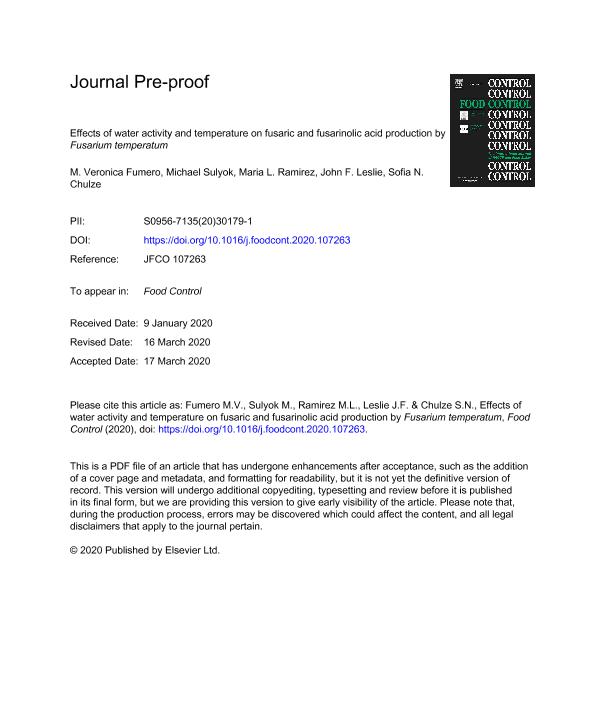Artículo
Effects of water activity and temperature on fusaric and fusarinolic acid production by Fusarium temperatum
Fecha de publicación:
20/08/2020
Editorial:
Elsevier
Revista:
Food Control
ISSN:
0956-7135
Idioma:
Inglés
Tipo de recurso:
Artículo publicado
Clasificación temática:
Resumen
Fusaric acid (FA) is a secondary metabolite produced by several Fusarium species that commonly is isolated from maize and maize-based foods and feeds, and is toxic to some plants and animals, most notably cotton. Fusarinolic acid (FnA) is closely related to FA and is enzymatically derived from it, but much less is known about its toxicity to humans and other animals. We determined the effects of water activity (aW – 0.95, 0.98 and 0.995), temperature (15°, 25° and 30 °C), incubation time (7, 14, 21 and 28 days) and their interactions on FA and FnA production by two strains of F. temperatum isolated from maize growing on sterile maize grain. The amount of FA and FnA accumulated was measured by high-performance liquid chromatography coupled with electrospray ionization tandem mass spectrometry (HPLC/ESI-MS/MS). Both compounds were accumulated by both strains of F. temperatum under all evaluated conditions. The amount of FnA produced always exceeded the amount of FA produced (max 50,000 ng/g and 4,500 ng/g, respectively). Temperature, aW, incubation time, and the two- and three-way interactions amongst them all significantly impacted FA and FnA accumulation. Factors favouring fungal growth and mycotoxin production include insect damage, high humidity, delays in harvest, and improper (wet) storage. Grain colonization by F. temperatum begins in the field, but fungal growth and mycotoxin production can easily continue in storage if conditions are right. Thus, from a toxicological point of view, F. temperatum represents a risk for maize under both field and storage conditions. Our data enable better risk estimates and strategies to reduce FA and FnA in the food and feed chains. The highest level of FA was detected at 0.995aW and was independent of temperature and length of incubation, suggesting that there is a limit to the amount of FA that can be accumulated by F. temperatum growing under laboratory conditions. Strikingly high amounts of FnA were observed under all incubation conditions, often exceeding FA levels by 20× to 200× . This result suggests that FnA is more important to the fungus than is FA, and that FA might be little more than an intermediate in a pathway to FnA. The role of the accumulated FnA is unknown, but its role as a toxin may have been discounted since studies to date report limited toxicity. However, if FnA is tested for toxicity at higher levels, such as those identified in this study, then it could have significant toxicological, or other effects that have not previously been considered.
Archivos asociados
Licencia
Identificadores
Colecciones
Articulos (IMICO)
Articulos de INSTITUTO DE INVESTIGACION EN MICOLOGIA Y MICOTOXICOLOGIA
Articulos de INSTITUTO DE INVESTIGACION EN MICOLOGIA Y MICOTOXICOLOGIA
Citación
Fumero, María Verónica; Sulyok, Michael; Ramirez, Maria Laura; Leslie, John; Chulze, Sofia Noemi; Effects of water activity and temperature on fusaric and fusarinolic acid production by Fusarium temperatum; Elsevier; Food Control; 114; 107263; 20-8-2020; 107-263
Compartir
Altmétricas




